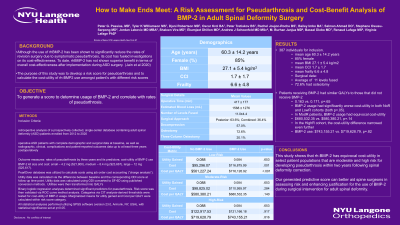How to Make Ends Meet: A Risk Assessment for Pseudarthrosis and Cost-Benefit Analysis of BMP-2 in Adult Spinal Deformity Surgery
How to Make Ends Meet: A Risk Assessment for Pseudarthrosis and Cost-benefit Analysis of BMP-2 in Adult Spinal Deformity Surgery
Friday, April 21, 2023


Peter G. Passias, MD
Spine Surgeon
NYU School of Medicine
New Canaan, CT, US
ePoster Presenter(s)
Introduction: It has yet to be determined whether certain patient populations in adult spinal deformity(ASD) obtain cost-utility benefit from use of BMP-2. We sought to generate a score to determine usage of BMP-2 and correlate with rates of pseudarthrosis.
Methods: ASD patients with 2-year(2Y) data included. BMP-2 kit size and cost: small – 4.2 mg ($21,800), medium – 8.4 mg ($23,667), large – 12 mg ($25,617). Published methods converted ODI to SF-6D. QALYs utilized a 3% discount rate for residual decline. Cost was calculated using CMS.gov definitions. Binary logistic regression generated established weights for predictive risk factors for development of pseudarthrosis. The total risk score was validated via Receiver Operating Characteristic (ROC) curve method and categorical thresholds were tested for cost-utility of BMP-2 usage. Marginalized means for utility gained and Cost-per-QALY were calculated within each risk score category, controlling for age, history of prior fusion, and baseline deformity and disability.
Results: Included: 387 ASD patients. 64% received BMP-2(1% small,4% medium,59% large). There were 17(4.4%) of patients that developed pseudarthrosis by two years, 9(2.3%) of which underwent reoperation. BMP-2 use did not lower pseudarthrosis rates overall(OR: 0.4,[0.2-1.04]). A predictive risk score for pseudarthrosis was formed by preoperative variables: age, frailty, history of diabetes, osteoporosis, depression, ASA grade, and baseline L4-S1 lordosis and T1PA. Via ROC method, predictive risk score generated an AUC of 0.87. BMP Risk Score categories were derived: < 2 No Risk(NoR), 2-3 Low Risk(LowR), 4-5 Moderate Risk(ModR), and >5 High Risk(HighR). Rates of pseudarthrosis: NoR – 0%;LowR - 1.6%;ModR – 9.3%;HighR – 24.3%. BMP-2 usage had worse cost-utility in both NoR and LowR, and similar cost-utility difference in the HighR cohort(BMP-2 use: $743,155.21 vs. $719,628.79, p=.82).
Conclusion : The generated predictive score can better aid spine surgeons assess risk and enhance justification for use of BMP-2 during surgical intervention for adult spinal deformity.
Methods: ASD patients with 2-year(2Y) data included. BMP-2 kit size and cost: small – 4.2 mg ($21,800), medium – 8.4 mg ($23,667), large – 12 mg ($25,617). Published methods converted ODI to SF-6D. QALYs utilized a 3% discount rate for residual decline. Cost was calculated using CMS.gov definitions. Binary logistic regression generated established weights for predictive risk factors for development of pseudarthrosis. The total risk score was validated via Receiver Operating Characteristic (ROC) curve method and categorical thresholds were tested for cost-utility of BMP-2 usage. Marginalized means for utility gained and Cost-per-QALY were calculated within each risk score category, controlling for age, history of prior fusion, and baseline deformity and disability.
Results: Included: 387 ASD patients. 64% received BMP-2(1% small,4% medium,59% large). There were 17(4.4%) of patients that developed pseudarthrosis by two years, 9(2.3%) of which underwent reoperation. BMP-2 use did not lower pseudarthrosis rates overall(OR: 0.4,[0.2-1.04]). A predictive risk score for pseudarthrosis was formed by preoperative variables: age, frailty, history of diabetes, osteoporosis, depression, ASA grade, and baseline L4-S1 lordosis and T1PA. Via ROC method, predictive risk score generated an AUC of 0.87. BMP Risk Score categories were derived: < 2 No Risk(NoR), 2-3 Low Risk(LowR), 4-5 Moderate Risk(ModR), and >5 High Risk(HighR). Rates of pseudarthrosis: NoR – 0%;LowR - 1.6%;ModR – 9.3%;HighR – 24.3%. BMP-2 usage had worse cost-utility in both NoR and LowR, and similar cost-utility difference in the HighR cohort(BMP-2 use: $743,155.21 vs. $719,628.79, p=.82).
Conclusion : The generated predictive score can better aid spine surgeons assess risk and enhance justification for use of BMP-2 during surgical intervention for adult spinal deformity.
